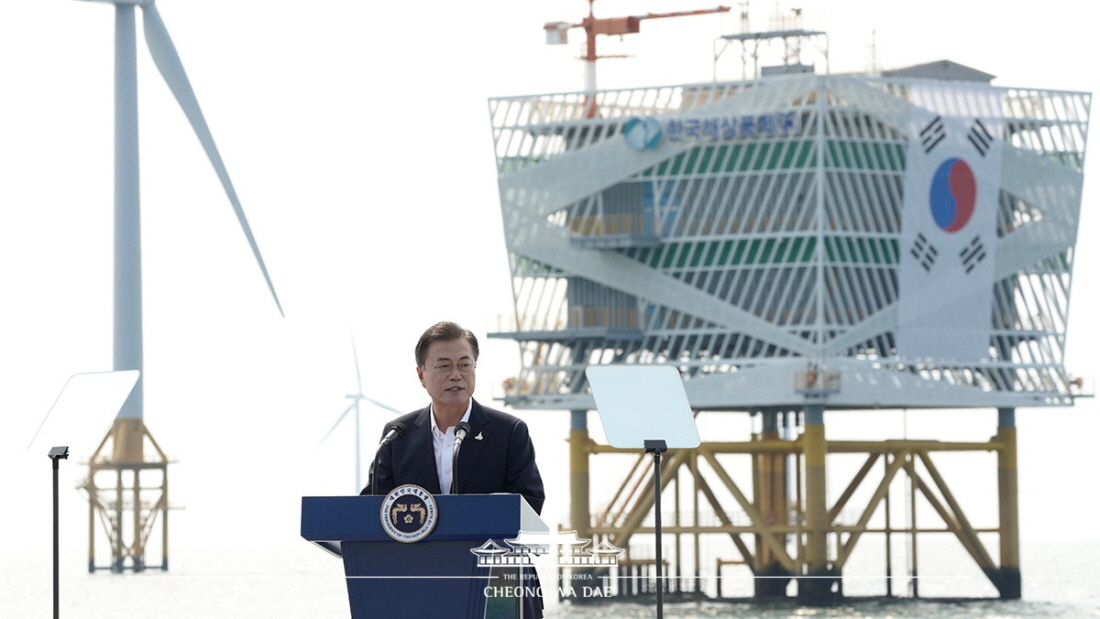이 웹사이트는 제19대 대통령 임기 종료에 따라 대통령기록관이 「대통령기록물 관리에 관한 법률」에 의해 이관받아 서비스하는 대통령기록물입니다. 자료의 열람만 가능하며 수정 · 추가 · 삭제는 불가능합니다.
다만, 「개인정보보호법」에 의하여 개인의 정보를 보호받기 원하시는 분은 관련 내용(요청자, 요청내용, 연락처, 글위치)을 대통령 웹기록물 담당자(044-211-2253)에게 요청해 주시면 신속히 검토하여 조치해 드리겠습니다. 감사합니다.
SPEECHES & REMARKS
BRIEFINGS
Remarks by President Moon Jae-in while Visiting Korean New Deal and Green Energy Site

Fellow Koreans and residents of Buan, Gochang and Jeollabuk-do Province,
Whenever I visit Jeollabuk-do, I come to admire its beautiful and lush nature. Now, it’s all the more refreshing with a view of the wind farm off the province’s southwestern shore from a ship in the middle of the sea.
Following the presentation of the Korean New Deal Initiative – the declaration of the Republic of Korea’s great transition – I’ve taken the first relevant steps here in Buan and Gochang, Jeollabuk-do. Joined by Jeollabuk-do residents, I find it truly meaningful to have this opportunity to introduce our people to offshore wind energy – the key to green energy.
Jeollabuk-do is recognized for its many signature products, but I think the spirit of cooperation and that of mutual benefit are its most famous features. This province has been leading the nation with each new spirit of the times through the volunteer righteous armies, the Donghak Peasant Revolution, struggles against imperial Japan and democratization movements. Furthermore, its spirit of mutual benefit has also been shining at this time to overcome the COVID-19 crisis. I extend my sincere gratitude to Jeollabuk-do residents, who have jointly shouldered burdens with neighbors and cooperated to overcome this crisis through the Good Landlord Campaign and “layoff-free city” declaration.
My appreciation should go to Jeollabuk-do Governor Song Ha-jin and government officials as well. They are safeguarding residents’ lives by employing the best epidemic prevention measures in the nation to stop the spread of COVID-19 as well as by drawing up the nation’s first locally commissioned emergency payments and supplementary budget.
Residents of Buan, Gochang and Jeollabuk-do,
Next to its beautiful nature and generous spirit of mutual benefit, the Green New Deal is becoming Jeollabuk-do’s third defining feature. Construction of the world’s largest floating photovoltaic solar power generation complex has begun in the Saemangeum area. In addition, the province is more strenuously pushing its Gunsan-type jobs and electric vehicle manufacturing cluster projects as part of the Green New Deal.
The Green New Deal is an initiative to leap from a carbon-dependent economy to a low-carbon one. It starts with switching coal-powered energy to green energy. Green energy constitutes a growth strategy to create jobs, reduce inequality and promote our society’s inclusiveness while at the same time resolving the climate crisis. It is the path for a mutually beneficial takeoff that will enable us to preemptively respond to ever-tightening international environmental regulations and to simultaneously develop new green industries and the existing industries where we have a competitive edge.
Green energy is also an area that will spearhead a great socioeconomic transition for our future generations while fundamentally reshaping the national energy system. It will also allow us to keep our energy security robust without relying on imports like coal and oil.
The world is already taking note of offshore wind energy, which has the greatest growth potential among green energy sources. As of last year, the world’s offshore wind energy accounted for a meager 4.5 percent of total wind power generation. However, newly built offshore wind farms are more than twice as large as those onshore.
As numerous countries expand their offshore wind power generation, the total energy produced in this way is expected to rise three-fold from the current amount to 177 gigawatts by 2030. Compared to onshore wind farms, those offshore boast more options for building sites, more feasible large-scale complexes and a higher capacity factor. They can also create as many as ten times more decent jobs than other types of power generation.
Offshore wind turbine towers utilize maritime plant, shipbuilding and equipment technologies, while their substructures are built with construction technologies.
Accordingly, expanding offshore wind power generation will create new demand for our shipbuilding, steel and construction industries, which are equipped with the world’s leading technologies.
Carbon fiber is used to make wind turbine blades; this will help related industries secure competitiveness in this new future material.
Residents of Buan, Gochang and Jeollabuk-do,
As offshore wind power generation is now in its beginning stage, it is important to secure a competitive edge ahead of others. We must make bold investments with a focus on our strengths and potential.
It’s true that there’s a long way to go before we can lead the global market. Nonetheless, it is not impossible either.
The Government’s goal is clear: leap into the ranks of the top five offshore wind energy powerhouses by 2030, using our nation’s geographical advantage as a peninsula. To this end, we have set three directions for implementation to expand wind power generation by a hundred-fold from the current 124 megawatts at three farms to 12 gigawatts by 2030.
First, the Government will actively provide support so that local governments can take the initiative to develop well-planned, large-scale wind farms.
We will find sites that are economically viable but less damaging to fisheries. Approval and licensing processes will be improved to facilitate the projects’ smooth implantation.
Second, the Government will do pump-priming to generate a market.
We will help stimulate initial demand primarily from large-scale projects so that domestic companies can gain competitiveness in pricing and technology. We will continue to invest in technological development. An expansion of infrastructure, including docks and ships used exclusively for wind farming, will follow.
Third, we will revive local economies through offshore wind power generation.
The sea has been the source of fishermen’s livelihood, and it is being greatly affected by climate change. Wind power generation will become a new source of income for fishermen and local residents anxious about declining fishery production, providing local economies with new vitality.
We will pay close attention to ensure that local residents are allowed to participate from the planning stage so that profits from power generation can be returned to them. The Government will encourage large-scale private sector investment to help create more than 80,000 jobs annually and strive to promote mutual benefits with local residents.
Fellow Koreans and residents of Buan, Gochang and Jeollabuk-do,
With green energy and offshore wind power, we will advance together and create growth engines while responding to climate change.
The offshore wind farm on Jeollabuk-do’s southwest coast has substructures with built-in aquaculture complexes. The system has been overhauled to allow fisheries and offshore wind power generation to co-exist so that local residents can receive greater profits.
This offshore wind farm in southwest Jeollabuk-do is itself a mutually beneficial complex. It is raising high expectations among the people. I hope the wind from the mutually beneficial takeoff started at this complex spreads to all the seas surrounding the Korean Peninsula.
Thank you.



